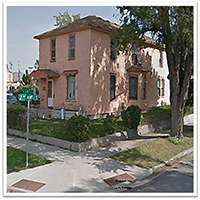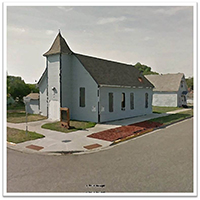Billings
The development of the black community in Billings closely mirrors that of Great Falls. Just as Great Falls benefited from the presence of the railroad for both jobs and new residents, Billings also became host to a transient population of African Americans in the 1880s and 1890s. Also like Great Falls, Billings exhibited a defined black neighborhood, centered around an AME church. The neighborhood came into being when black pioneer Walker Browning took up residence just south of the railroad in 1883. It is not clear whether he was forced to live on the Southside per some segregation-era ordnance, or whether he chose that location, and the subsequent decades saw African Americans only taking up residence in that part of town. The latter seems rather unlikely, especially since another Montana city, Great Falls, had already passed just such a housing ordinance. Nevertheless, as would prove to be the case in Great Falls, a geographically centered neighborhood served the efficacy and cohesion of the greater black community.
As black residents established themselves geographically on the Southside, they also established themselves professionally as cooks, carpenters, engineers, porters, barbers, tailors, dressmakers, inn keepers, saloon owners, janitors and even a law office stenographer. Following the established trends of community development, the black community’s wide ranging success in the professional realm continued to be supplemented by a solid foundation in the religious and social realms. Early members of black Billings formed the first African Methodist Episcopal Church in 1900, and finally purchased a building for use as a sanctuary in 1916. However, the salt-box style church sat eleven blocks north of the railroad tracks, quite the walk for its entire congregation, and so that year, they moved the entire building to its current location at 402 South 25th Street. The church now stood only blocks from Walker Browning’s home, at the time belonging to his daughter and her husband—the esteemed Calvary Captain Horace Bivins—as well as Mrs. Browning’s Furnished Rooms, at 121 S 26th St. The McCabes, Emmons, and other founding members also lived within a few blocks of the new location. In time, the membership of the small chapel would grow to over thirty or forty members, with many more attending. Wayman’s Chapel continued to see an inconsistency in the position of spiritual leader of the congregation for many years. Not until the hiring of Rev Robert Freeman in 1957, would the church have a steady pastor. Until his death in 1997, Freeman served as a pillar of the dwindling African American community.
Civic, social, religious, and professional participation by Billings’ black residents continued throughout the first three decades of 20th century. However, with drought, depression, and booming war economies on the west coast, African Americans left Montana and Billings in droves before the midpoint of century. The geographic nature of Billings’ black neighborhood helped retain some semblance of community long after most of its founding members had died or left for better conditions. Unfortunately, much of the original Walker Browning-era neighborhood has been taken over by parking lots and the continued development of the oil plant that dominated the Southside of Billings. Today, only a fraction of properties once owned and occupied by black families remain, including Mrs. Browning’s Furnished Rooms at 121 South 26 th Street, and the Wayman Chapel at 402 South 25 th Street.
Billings Historic Properties

Mrs. Browning’s Furnished Rooms
121 South 26th Street

Wayman Chapel
402 South 25th Street
